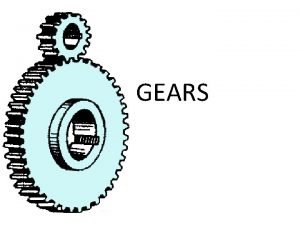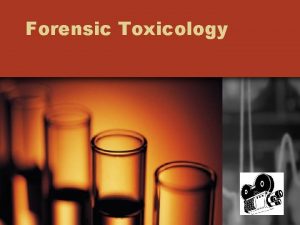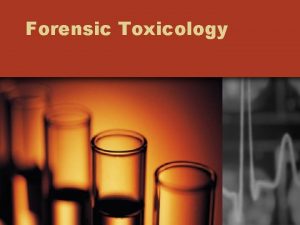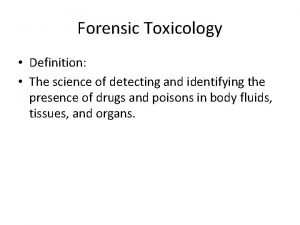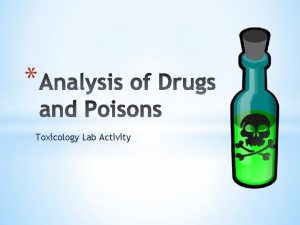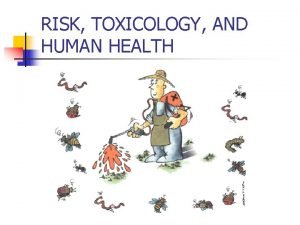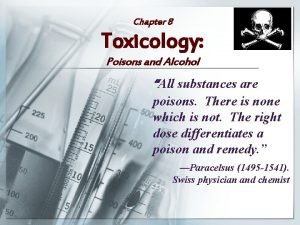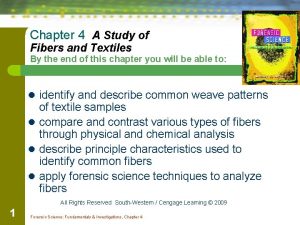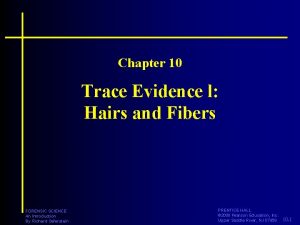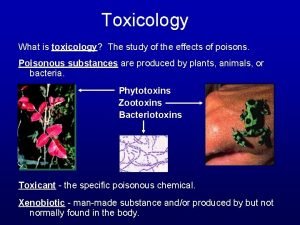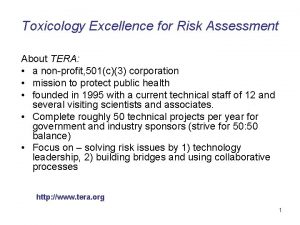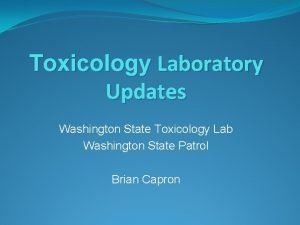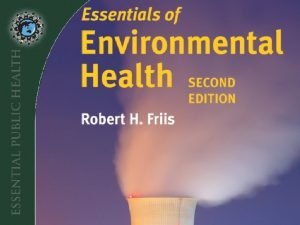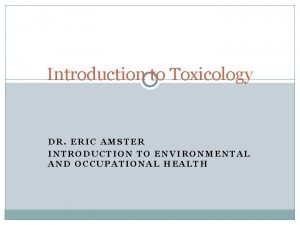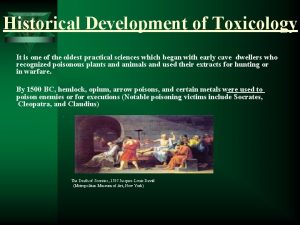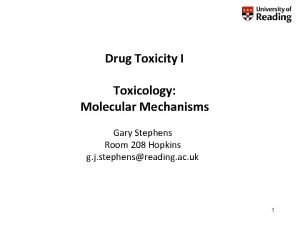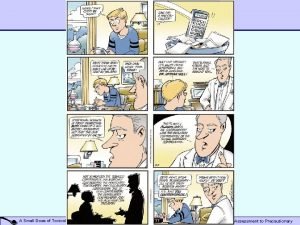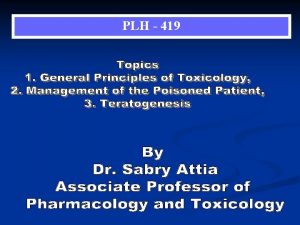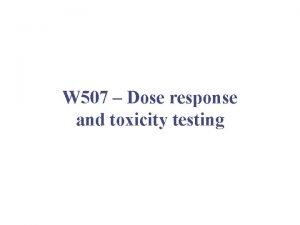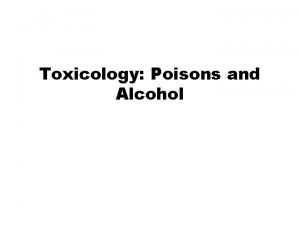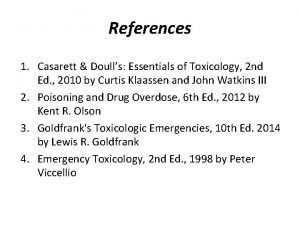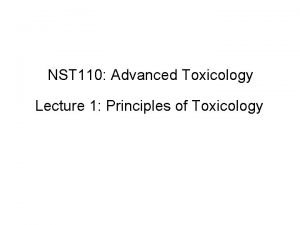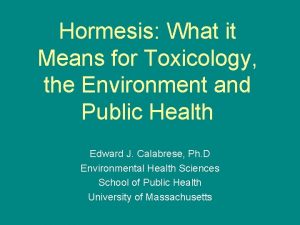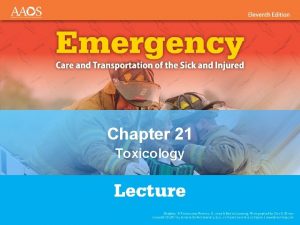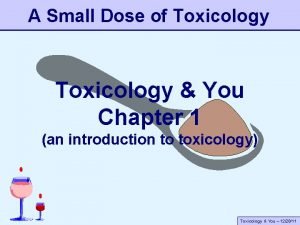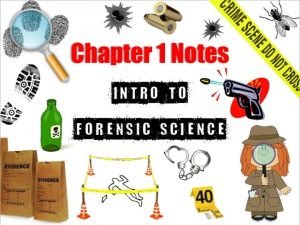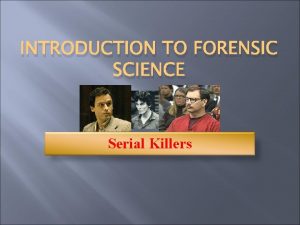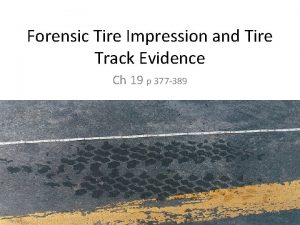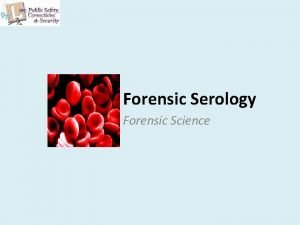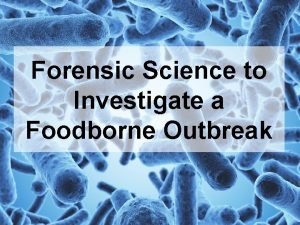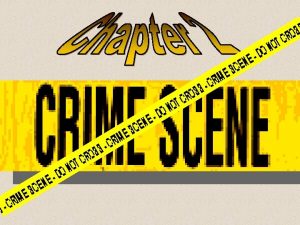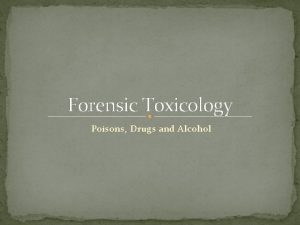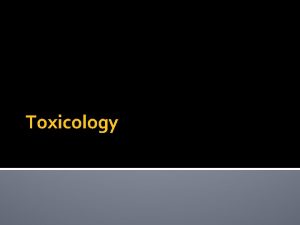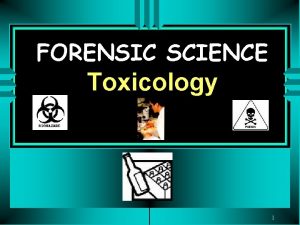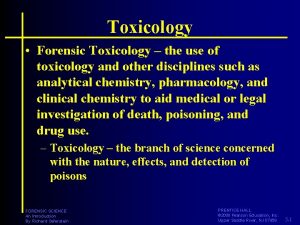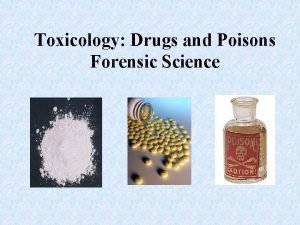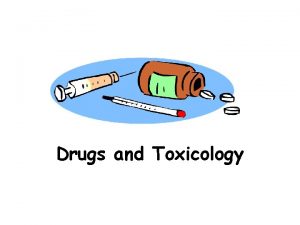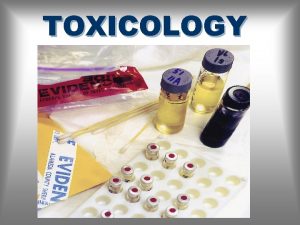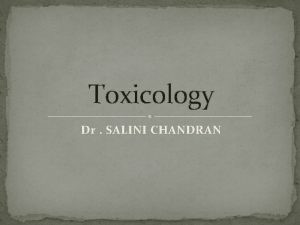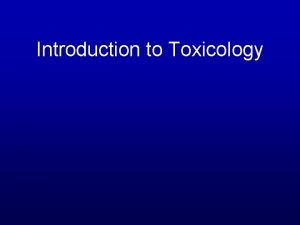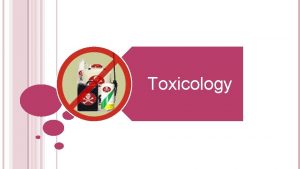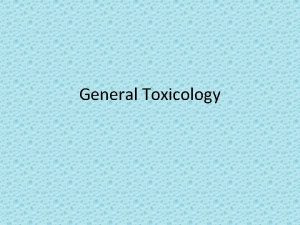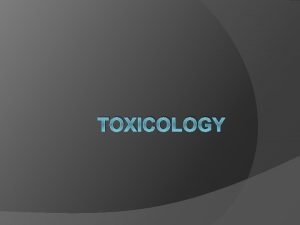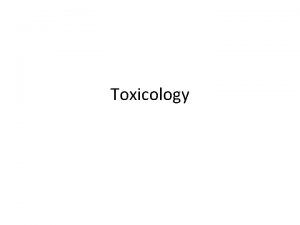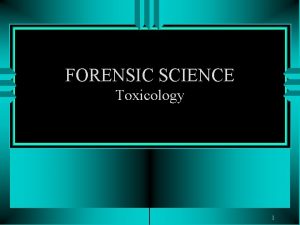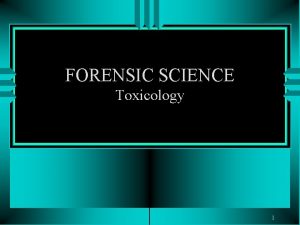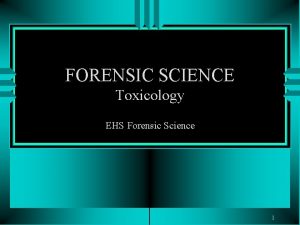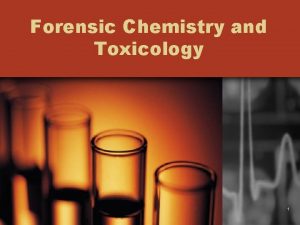Drugs and Forensic Toxicology Forensic Science Addendum to





















































- Slides: 53

Drugs and Forensic Toxicology Forensic Science

Addendum to “Bath Salts” Video… o As of 2/19/14, “Bath Salts” are illegal in 41 states with legislation pending in others. o In July of 2012 President Obama signed a bill amending federal drug policy to ban “bath salts. ” o “Bath salts” are bad news!!! Stay away!

What is toxicology? o Toxicology is the study of drugs and poisons, and their interactions with or effects on the body o Forensic Toxicology is the application of toxicology to the law, including n n n Workplace or Forensic Drug Testing Postmortem Toxicology Human Performance Testing

History of Toxicology o Socrates was one of the earliest reported victims of poisoning, by hemlock, in 399 BC. o By the 17 th century, it was not uncommon for rich European families to use poisoning as a means of settling disputes. n Arsenic became known as “inheritance powder. ”

History of Toxicology o Mathieu Orfila (1787 -1853) is considered one of the fathers of toxicology as he helped to develop a method of chemical analysis to identify arsenic and other toxins in human tissue o Today, less than 0. 5% of all homicides result from poisoning

Role of the Toxicologist o Studies body fluid, tissue, and organs for drugs and/or poisons o Must detect, identify, quantify, and assess toxicity n May have extremely minute quantities to test o May conduct postmortem pathological examinations, and examination of personal effects and empty containers, etc.

Collecting Toxicological Evidence o When possible, collect both blood and urine n Collect two voids (samples) of urine in separate specimen containers n Collect a sample of blood if a physician or registered nurse (RN) is available

(stop)

Toxicology of Alcohol o Approximately 40% of traffic deaths in the U. S. are alcohol-related (2008) o Toxicologists have had to develop specific procedures for measuring the degree of alcohol intoxication o Methods for diagnosis must be defendable within the framework of the legal system

Toxicology of Alcohol o Alcoholic beverages contain ethanol, ethanol also called ethyl alcohol, which is obtained by the fermentation of sugars from grains, fruits, and vegetables. o Alcohol is a depressant, a chemical that slows the heart rate and brain activity, and causes drowsiness

Alcohol Metabolism o Alcohol is absorbed through the walls of the stomach and small intestine, and distributed by blood throughout the body. o In the liver, the enzyme alcohol dehydrogenase (ADH) breaks down ethanol into acetylaldehyde (causes hangovers), then eventually into carbon dioxide and water. o The liver can normally metabolize 1 -2 drinks (15 -30 m. L or up to 1 ounce) an hour. When a person drinks more than the liver can metabolize, the excess is distributed to the tissues of the body which can damage them.

Alcohol in the Blood o Blood Alcohol Content (BAC) is usually written as a decimal n n Example: 0. 08 This means there are 8 g of alcohol per 10, 000 m. L of blood; your blood is 0. 08% alcohol. Effects of Alcohol at Different BACs 0. 03 – 0. 12 0. 25 – 0. 40 0. 35 – 0. 50 0. 40 and up euphoria vomiting, loss of bladder control circulatory and respiratory system impairment coma and death

BAC and the Law o A BAC greater than 0. 08 is considered to be “drunk driving” o Implied consent says drivers who receive a driver's license are automatically consenting to be tested for blood alcohol content if a police officer has probable cause n While a driver can refuse to take this test, implied consent laws often automatically revoke licenses on the spot.

Field Sobriety Tests o If a police officer smells alcohol on a driver, he/she may perform field sobriety tests, including: n Horizontal gaze nystagmus (HGN) test p Nystagmus is involuntary jerking movements of the eyes; more pronounced when intoxicated n Walk and turn p Heel to toe in a straight line, following directions n One leg stand p Count aloud by 1000’s for 30 seconds or recite alphabet backwards

o Watch walk and turn video o Try it out with a partner

Alcohol Breath Test o 90% of alcohol is processed by the liver. The remaining 10% is excreted through breath, perspiration, and urine o A breath test, such as a Breathalyzer measures the amount of alcohol in exhaled air. o The amount of alcohol in breath is 1/2100 the amount in blood. n 2100 m. L of air has the same amount of alcohol as 1 m. L of blood.

Negative Effects of Alcohol o All alcohols are toxic to the body. o Consumption of alcohol can lead to liver damage, possibly cirrhosis. Chronic alcohol abuse can lead to Korsakoff’s Syndrome. o Driving while intoxicated can have deadly results. o Alcohol may change the effect of medications. n Never consume alcohol while taking drugs with a sedative effect.

(stop)

Drugs o “Drug” can mean different things… n Illicit or illegal drugs that have no accepted medical use in the US n Controlled substances: substances legal drugs whose sale, possession, and use are restricted because of their effects and the potential for abuse. o Drugs can fall into one of several different classes: narcotics, hallucinogens, depressants, stimulants, club drugs, and steroids

Types of Drugs: Narcotics o Narcotics reduce pain by suppressing the central nervous systems ability to relay pain messages to the brain n Pain relievers are called analgesics o Narcotics induce sleep and depresses vital body functions such as blood pressure, pulse, and breathing

Types of Drugs: Narcotics o Varieties of narcotics: n Opiates: derived from the Asian Poppy p Herione, n morhpine, codeine Synthetic opiates: man-made p Methadone: given to heroine addicts to try and break their addiction p Oxycodone (Oxy. Contin or Percocet) p Hydrocodone (Vicodin) o Overdose on narcotics can result in difficulty breathing, low blood pressure, loss of consciousness, and possibly coma and death.

Types of Drugs: Hallucinogens o Hallucinogens alter the user’s perceptions, thinking, self-awareness, and emotions. o Some hallucinogens can cause panic attacks, seizures, headaches, and sometimes psychosis that can last for weeks. o Many hallucinogens, particularly PCP, increase the user’s heart rate, which could lead to heart failure.

Types Of Drugs: Hallucinogens o Varieties of Hallucinogens n Marijuana (from cannabis plant) p The most widely used illicit drug in the U. S. p Contains tetrahydrocannabinol (THC) p Has medical uses such as treating glaucoma and relieving nausea due to chemotherapy n n n MDMA (“Ecstacy”) Mescaline (from Peyote cactus) LSD (Lysergic Acid, or simply “Acid”) PCP (phencyclidine or “Angel Dust”) Mushrooms (contain psilocybin)

Types of Drugs: Depressants o Depressants are used to relieve anxiety and produce sleep. o Depressants reduce body functions such as heart rate. o Overdose can cause coma and death. o Mixing depressants with other drugs or alcohol can increase their effects and health risks.

Types Of Drugs: Depressants o Varieties of Depressants: n n n Alcohol Barbiturates: “downers” such as Phenobarbital and Methaqualone (also called Quaaludes, illegal) Anti-psychotic and anti-anxiety drugs including benzodiazepines such as Diazepam (Valium) Inhalants (“huffing”) Sedatives, muscle relaxers, etc. Marijuana and opiates (like morphine) are also considered depressants.

Types of Drugs: Stimulants o Stimulants increase feelings of energy and alertness while suppressing fatigue and appetite. o Also called “uppers. ” o Depression often results as the drug wears off. o Stimulants are highly addictive. o Overdose can result in irregular heart beat, heart attack, stroke, seizures, coma, and death.

Types of Drugs: Stimulants o Varieties of Stimulants n n Amphetamines, also called “speed. ” Cocaine, including crack cocaine p Derived from the South American coca plant p Addictions to cocaine are very difficult to overcome n Methamphetamines, also called “meth. ” p Typically methamphetamines are more potent and dangerous than amphetamines

Meth Addiction

Types of Drugs: “Club Drugs” o Club drugs are called such because they are most often used at nightclubs, bars, and raves (all night dance parties) o Varieties of Club Drugs” n Methylenedioxymethamphetamine (aka MDMA or Ecstasy) p Chronic use can cause body system breakdown, severe brain damage, memory loss, and seizures n Ketamine or “Special K” is an animal anesthetic used by veterinarians

Types of Drugs: “Club Drugs” o Date Rape Drugs are called that because they are often associated with drug-facilitated sexual assault, rape, and robbery. o These drugs can produce increased libido and depress the central nervous system, resulting in loss of consciousness and memory. o Varieties include GHB and Rohypnol (also called “Roofies”)

Types of Drugs: Anabolic Steroids o Anabolic Steroids promote cell division and tissue growth o Athletes may take steroids to increase muscle mass o Anabolic steroids are chemically related to testosterone o Side effects include liver malfunction, cancer, breast development in males, masculinizing effects in females, diminished sex drive in males, unpredictable moods (“roid rage”), personality changes, depression, hypertension, and high cholesterol

Be careful… o All of these drugs, even the legal ones, can have harmful side effects. Overdose can be deadly. o Assignment: Drug Brochures

Poisons!

Toxins and Poisons o A poison is any substance that causes disturbance to an organism o More specifically, a toxin is poison produced naturally by an organism n Examples: snake venom, poison ivy

Intake of Poisons o Poisons enter and affect the body in different ways: n Ingestion (poisons are eaten) p 90% of all poisonings involve children swallowing household products or medicine n Inhaled p Example: n carbon monoxide, sarin nerve gas Injected p Heroine n Absorbed (through skin, eyes, or mucous membranes) p Poison sumac

Poisons: Pesticides o Pesticides are by definition poisons as they are used to kill organisms that threaten plants such as food crops n Example: DDT (for mosquitoes) o These chemicals lead to an excess of the neurotransmitter acetylcholine n Overdose can lead to muscle spasms, seizures, anxiety, rapid heartbeat, sweating, diarrhea, and at high concentrations coma and death

Poisons: Heavy Metals o Metal compounds can enter the body by ingestion, inhalation, or absorption through the skin or mucous membranes o Metals are stored in soft body tissues and damage organs o Examples: n n n Lead Mercury Arsenic Cyanide Strychnine

Poisons: Heavy Metals o Arsenic Poisoning n Within 30 minutes: abdominal pain, severe nausea, vomiting and diarrhea, muscle cramps, convulsions, kidney failure, delirium, and death. o Cyanide Poisoning n n Can be fatal in 6 -8 minutes. Signs of poisoning include weakness, confusion, coma, pink skin, and an almondlike odor.

Poisons: Bioterrorism Agents o A bioterrorism attack is the deliberate release of viruses, bacteria, toxins or other harmful agents used to cause illness or death in people, animals, or plants. Examples include: n n n Ricin Anthrax Mustard Gas p used in World War I p A man-made gas p Forms large blisters on exposed skin and the lungs

Poisons: Bioterrorism Agents o Ricin comes from castor beans. n Can be inhaled as a mist or powder, or ingested in food n Amount the size of a pin head can be deadly! n Within a few hours of exposure the victim may die p If inhaled effects include fever, cough, nausea, sweating, low blood pressure, fluid in the lungs, and death p If ingested effects include vomiting diarrhea, dehydration, low blood pressure, hallucinations, seizures, and death

Poisons: Bioterrorism Agents o Anthrax poisoning is caused by the spores of the bacteria Bacillus anthracis o Anthrax can enter the body through inhalation, ingestion, or skin absorption o Symptoms depend on exposure type: n n n Inhalation: flu-like symptoms that become progressively worse and usually result in death. Ingestion: vomiting, fever, abdominal pain, and severe diarrhea. 25 - 60% fatal. Skin: itchy bumps that develop into sores with a black center. Death is rare with appropriate treatment.

(stop)

Drug Control Laws o There are varying levels and penalties based on: n n manufacture vs. distribution vs. possession type, amount, concentration

Controlled Substance Act o The Controlled Substances Act – the federal law that establishes five classifications (“schedules”) of controlled dangerous substances on the basis of a drug’s potential abuse, potential for physical and psychological dependence, and medical value o The U. S. Attorney General has the authority to add, delete, or reschedule a drug as needed

Controlled Substances Act Schedule I o High potential for abuse o no currently accepted medical use in the U. S. o Examples: heroin, marijuana (some states), methaqualone, LSD

Controlled Substances Act Schedule II o High potential for abuse o some accepted medical use with severe restrictions, o potential for severe physiological and psychological dependence o Examples: morphine, cocaine, methadone, PCP, most amphetamine preparations, most barbiturate preparations, and medical marijuana (some states)

Controlled Substances Act Schedule III o Less potential for abuse o currently accepted medical use o potential for low to moderate physiological and high psychological dependence o All barbiturates not included in Schedule II, such as codeine preparations and anabolic steroids

Controlled Substances Act Schedule IV o Low potential for abuse o current medical use o Examples: tranquilizers such Valium Schedule V o Low abuse o medical use o less potential for dependence than Schedule IV o Examples: Robitussin cough syrup, nonnarcotic medicinal ingredients and some opiate drug mixtures in low concentrations

Criminal Penalties o Schedule I and II have the most severe penalties o The Controlled Substance Act controls substances that are chemically similar or related to controlled substances such as “designer drugs” o It also regulates the manufacture and distribution of chemical compounds used by clandestine labs to make drugs

Testing For Drugs o Bodily fluids and tissues might be tested for the presence of drugs, especially: n n n Blood (drug remains for 24 hours) Urine (drug remains for 72 hours) Hair (drug is permenantly embedded in hair’s protein structure) o Location along hair shaft gives clues to time of drug use. If drug is found closer to the root, use was more recent.

Testing For Drugs o There are several types of tests to screen for the presence of drugs n n n Screening test: preliminary test that reduces number of possibilities Confirmatory test: a single test that identifies a specific substance Color test: changes color when a specific substance is present Microcrystalline test: identifies drug based on color and shape of crystals formed Immunoassay: uses drug specific antibodies to detect low concentrations of drugs

Testing For Drugs o Chromatography: separates a chemical into its components (often different colors) so they can be identified o Spectrophotometry: Examines the wavelength and frequencies of light absorbed by a substance to identify it

(end) o Watch drug dog video
 Cycloidal teeth consist of *
Cycloidal teeth consist of * Forensic science timeline
Forensic science timeline Forensic toxicology definition
Forensic toxicology definition Definition of forensic toxicology
Definition of forensic toxicology Forensic toxicology definition
Forensic toxicology definition Forensic toxicology lab activity
Forensic toxicology lab activity Forensic toxicology vocabulary
Forensic toxicology vocabulary What is an escalation clause
What is an escalation clause Va loan intermittent occupancy
Va loan intermittent occupancy Nbn d 51-001
Nbn d 51-001 My favourite subject is pe
My favourite subject is pe Forensic pathologist vs forensic anthropologist
Forensic pathologist vs forensic anthropologist Who is this
Who is this Chapter 8 toxicology poisons and alcohol
Chapter 8 toxicology poisons and alcohol Toxicology types
Toxicology types Toxicology and applied pharmacology
Toxicology and applied pharmacology Annual review of pharmacology and toxicology
Annual review of pharmacology and toxicology Food safety and toxicology
Food safety and toxicology Drug identification and toxicology
Drug identification and toxicology Forensic science fundamentals and investigations chapter 6
Forensic science fundamentals and investigations chapter 6 What is a textile in forensic science
What is a textile in forensic science Chapter 1 introduction to forensic science and the law
Chapter 1 introduction to forensic science and the law Hairs and fibers in forensic science
Hairs and fibers in forensic science Toxicology is the study of
Toxicology is the study of Tera toxicology
Tera toxicology Definition of environmental toxicology
Definition of environmental toxicology Toxicology management
Toxicology management Washington state patrol toxicology lab
Washington state patrol toxicology lab Toxicology definition
Toxicology definition Nc medical examiner and coroner guidelines
Nc medical examiner and coroner guidelines Toxicology
Toxicology Examples of toxicology
Examples of toxicology Toxicology
Toxicology Toxicology
Toxicology Toxicology defination
Toxicology defination Accipitridae
Accipitridae W 507
W 507 Toxicology effects
Toxicology effects Toxicology effects
Toxicology effects Ld50 examples
Ld50 examples Hormesia
Hormesia Dumbels emt
Dumbels emt A small dose of toxicology
A small dose of toxicology Sola pith hymen
Sola pith hymen Keratin definition forensics
Keratin definition forensics Mass spectrometry in forensic science
Mass spectrometry in forensic science Branches of forensic science
Branches of forensic science Richard ramirez ac dc hat for sale
Richard ramirez ac dc hat for sale Tire track evidence
Tire track evidence Serology forensic science
Serology forensic science Unit 1 introduction to forensic science
Unit 1 introduction to forensic science Forensic science foodborne outbreak investigation answers
Forensic science foodborne outbreak investigation answers What is forensic science definition
What is forensic science definition Where does forensic science begin
Where does forensic science begin
